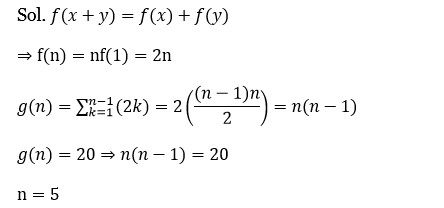Functions
Get insights from 16 questions on Functions, answered by students, alumni, and experts. You may also ask and answer any question you like about Functions
Follow Ask QuestionQuestions
Discussions
Active Users
Followers
New answer posted
2 months agoContributor-Level 10
f (x) = 2e²? / (e²? +e? ) and f (1-x) = 2e²? / (e²? +e¹? )
∴ f (x) + f (1-x) = 1/2
i.e. f (x) + f (1-x) = 2
∴ f (1/100) + f (2/100) + . + f (99/100)
Σ? f (x/100) + f (1-x/100) + f (1/2)
= 49 x 2 + 1 = 99
New answer posted
2 months agoContributor-Level 10
lim? (x→7) (18- [1-x])/ ( [x-3a])
exist & a∈I.
= lim? (x→7) (17- [-x])/ ( [x]-3a)
exist
RHL = lim? (x→7? ) (17- [-x])/ ( [x]-3a) = 25/ (7-3a) [a ≠ 7/3]
LHL = lim? (x→7? ) (17- [-x])/ ( [x]-3a) = 24/ (6-3a) [a ≠ 2]
LHL = RHL
25/ (7-3a) = 8/ (2-a)
∴ a = -6
New answer posted
2 months agoContributor-Level 10
A function f (x) is continuous at x=1, so lim (x→1? ) f (x) = lim (x→1? ) f (x) = f (1).
Assuming a piecewise function like f (x) = { -x, x<1; ax+b, x1 } (structure inferred from derivative).
Continuity at x=1: f (1) = 1. a (1)+b = 1 => a+b=1.
The function is differentiable at x=1. The derivative of f (x) at x=1 from the left is -1. The derivative from the right is a.
So, a = -1. (The image has 2a = -1, which would imply a function like -x and ax²+b). Let's assume f' (x) = 2a for x>1.
2a = -1 => a = -1/2.
From a+b=1, b = 1 - a = 1 - (-1/2) = 3/2.
So, a = -1/2 and b = 3/2.
New answer posted
2 months agoContributor-Level 10
Given the function f (x) = cosec? ¹ (x) / √ {x - [x]} where [x] is the greatest integer function.
The domain of cosec? ¹ (x) is (-∞, -1] U [1, ∞).
For the denominator to be defined, x - [x] ≠ 0, which means {x} ≠ 0 (the fractional part of x is not zero). This implies that x cannot be an integer (x ∉ I).
Combining these conditions, the domain is all non-integer numbers except for those in the interval (-1, 1).
New answer posted
2 months agoContributor-Level 10
19.00
Only '2' in range → 1 function
one element out of 1, 3, 4 is in range with '2'
number of ways = ³C? * (3!/(2!1!)) * 2! = 18
(Select one from 1, 3, 4 and distribute among a, b, c)
Total function = 1 + 18 = 19
Taking an Exam? Selecting a College?
Get authentic answers from experts, students and alumni that you won't find anywhere else
Sign Up on ShikshaOn Shiksha, get access to
- 65k Colleges
- 1.2k Exams
- 679k Reviews
- 1800k Answers

